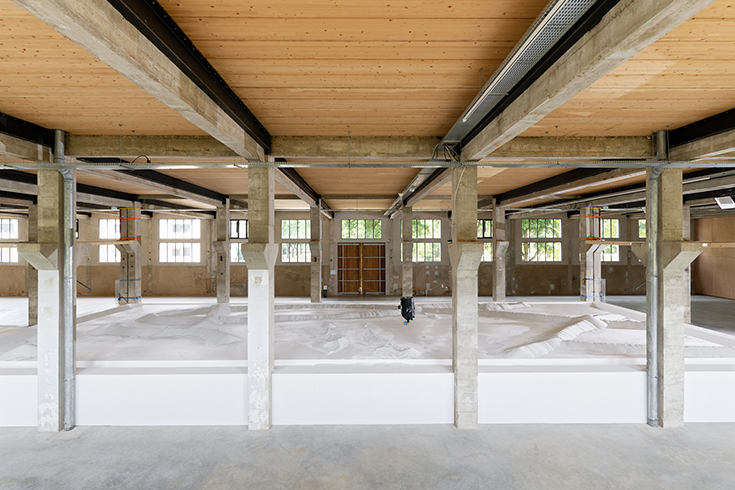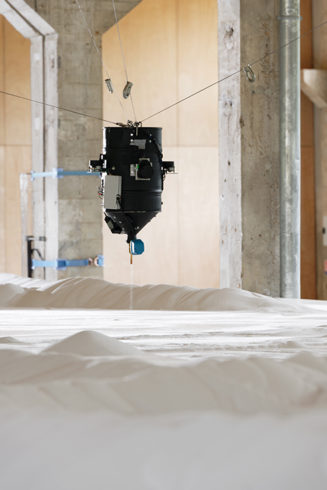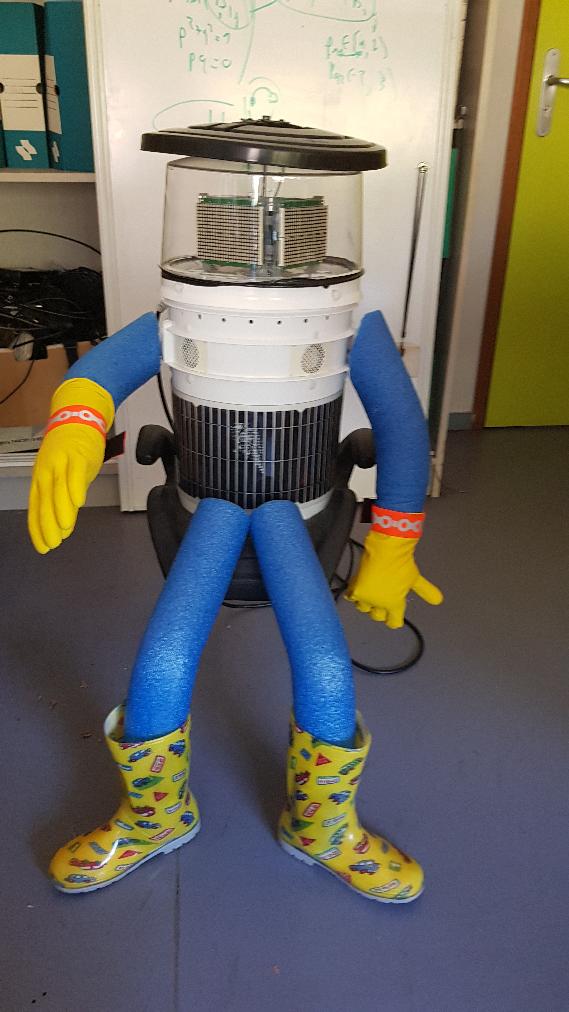Section: New Results
Robotics
Analysis of Cable-driven parallel robots
Participants : Jean-Pierre Merlet [correspondant] , Yves Papegay.
We have continued the analysis of
suspended CDPRs for control and design
purposes. This analysis is heavily dependent on the behavior of the
cable. Three main models can be used: ideal (no deformation of the
cable due to the tension, the cable shape is a straight line between
the attachments points), elastic (cable length changes according
to the tension to which it is submitted, straight line cable shape)
and sagging (cable shape is not a line as the cable is submitted to its
own mass). The different models leads to very different analysis with
a complexity increasing from ideal to sagging. All cables exhibit
sagging but the sagging effect is often neglected if the CDPR is
relatively small while it definitively cannot be neglected for large
CDPRs. The most used sagging model is the Irvine
model [24]. This is a non algebraic planar model with
the upper
attachment point of the cable is supposed to be grounded: it provides the
coordinates of
the lowest attachment point
The direct kinematics relies on an accurate estimation of the cable
lengths that is usually based on the measurement of the winch drum
rotation. We have evaluated the influence of uncertainties in the
cable length measurement on the result of the FK
[19] and have shown that for a poor robot
geometry
(which was for example the case for the
prototype described in section 6.1.2 for which the geometry was
imposed)
this
influence may be quite large .
An usual strategy to decrease this uncertainty for small to
medium-sized CDPR
is to use a drum with a cable spiral guide for the coiling which
impose a coiling path for the cable. However this strategy
is unfeasible for
large and very large CDPR (that we called Ultrabot) for which
the large length of the cables
impose to have several layers on the drum and therefore leads to a more
erratic coiling process that leads to possibly large errors of the
cable lengths estimation. To get a better estimation of the cable
lengths we have proposed an original method, based on the Vernier
principle [21]. The idea is to have several small
colored marks on the cable at known distances from the end-point of
the cable and to have several color sensors in the mast of the
CDPR. We have first shown that if 3 colors (e.g. RGB) were used, then an
appropriate disposition of the marks on the cable allows to have up to
29 marks on the cable so that the sequence of 3 successive colors is
always unique. Hence by coiling the cable and detecting the 3
successive color
detected by a sensor allows to determine exactly the distance between
the sensor and the cable end-point, i.e. to calibrate the cable
length. Calibration is always an issue for CDPR which uses usually
incremental encoders for measuring the drum rotation (which explain
why we have also proposed another approach [18]. Then we have
considered the sequence of color detection when coiling the cable,
starting from its largest length. We have looked at the distribution
of cable length changes
We have also continued to investigate the calculation of planar cross-sections of the workspace for CDPR with sagging cables. We have shown in a previous paper that the border of this workspace was either determined by cable length limits but also by the singularity of the kinematics equations. Hence these singularities play an important role for the design of a CDPR. We have started a preliminary investigation on this topic [20]. We have shown that these singularities may be classified in two categories:
-
classical singularity which corresponds to the singularity of parallel robots with rigid legs which basically implies that the mechanical equilibrium of the system cannot be obtained, leading to a motion of the platform even if the actuators are locked
-
full singularity which are singularity of the kinematics equations but are not classical singularity. In this case mechanical equilibrium is obtained but the CDPR is unable to move in a given direction
We have also developed an algorithm that check if a full singularity exists in the neighborhood of a given pose and to locate it with an arbitrary accuracy.
Cable-Driven Parallel Robots for large scale additive manufacturing
Participants : Jean-Pierre Merlet, Yves Papegay [correspondant] .
Easy to deploy and to reconfigure, dynamically efficient in large workspaces even with payloads, cable-driven parallel robots are very attractive for solving displacement and positioning problems in architectural building at large scale seems to be a good alternative to crane and industrial manipulators in the area of additive manufacturing. We have co-founded in 2015 years ago the XtreeE (www.xtreee.eu) start-up company that is currently one of the leading international actors in large-scale 3D concrete printing.
We have been contacted in 2018 by the artist
Anne-Valérie Gasc that is interested in mimicking the 3D additive
manufacturing process on large scale for a live art performance.
She was interested in a mean for widespreading glass micro-beads on a
given trajectory over a 21
|
Killing robots
Participant : Jean-Pierre Merlet [correspondant] .
The director, Linda Blanchet, of a theater company has contacted us for helping organizing a theater event, Killing Robots, centered on the story of Hitchbot, a passive 70cm high mannequin designed by Canadian colleagues, that was put on the side-way of roads in Canada so that people may transport it, the purpose being to study the human interaction with people during a travel from the east to the west cost of Canada. The mannequin was located through a GPS and has taken a picture of its surrounding every 20 minutes while it was active. This mannequin indeed performs this travel in 15 days and a similar experiment was then scheduled in the US, the purpose being to go from Boston to San Francisco. Unfortunately after 5 days of travel the mannequin was discovered completely dismantled in Philadelphia. The idea of Linda Blanchet's performance was to propose a thriller based on the robot data for discovering who has dismantled the robot and in parallel to have the robot interacts with the actors to describe its feeling. For that purpose it was necessary that the robot becomes actuated while keeping its appearance identical to the original model. We have therefore retrieved a clone of the original Hitchbot and we have actuated the arms and head, so that the robot was able to move them, adding a lidar on top of the head so that it was able to locate the actors on stage (figure 2).
The Canadian colleague have also provided a conversational agent so that the robot was able to speak with a learning process. The opening of the performance was done on November 6 at the National theater of Nice and it is now performing in various places in France. We have been present at several of them to interact with the public at the end of the performance. From a scientific viewpoint our interest in this exhibition was to better understand why adding motion to a mannequin modify drastically the perception of the robot by the public. These understanding will help to work on the factors that increase the acceptance of a technological object by the public, which is clearly a major factor for the efficiency of our assistance devices.





